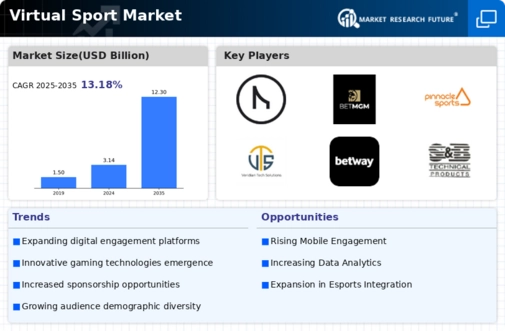The Virtual Sport Market is currently characterized by a dynamic competitive landscape, driven by technological advancements and an increasing consumer appetite for immersive gaming experiences. Key players such as Inspired Entertainment (US), Kambi Group (SE), and Scientific Games (US) are at the forefront, each adopting distinct strategies to enhance their market positioning. Inspired Entertainment (US) focuses on innovation through the development of new virtual sports products, while Kambi Group (SE) emphasizes partnerships with operators to expand its reach. Scientific Games (US) is leveraging its extensive portfolio to integrate advanced analytics and AI into its offerings, thereby enhancing user engagement and operational efficiency. Collectively, these strategies contribute to a competitive environment that is increasingly reliant on technological differentiation and strategic collaborations.
In terms of business tactics, companies are increasingly localizing their offerings to cater to regional preferences, which appears to be a critical factor in their success. The market structure is moderately fragmented, with several players vying for market share, yet the influence of major companies is palpable. This competitive structure allows for a diverse range of products and services, fostering innovation while also presenting challenges in terms of maintaining a competitive edge.
In August 2025, Inspired Entertainment (US) announced the launch of its new virtual sports platform, which integrates cutting-edge graphics and real-time data analytics. This strategic move is likely to enhance user experience and engagement, positioning the company as a leader in the virtual sports segment. The emphasis on high-quality graphics and data-driven insights may attract a broader audience, thereby increasing market share.
In September 2025, Kambi Group (SE) entered into a strategic partnership with a leading European sportsbook operator, aiming to enhance its virtual sports offerings. This collaboration is expected to leverage Kambi's technology and the operator's market presence, potentially leading to increased revenue streams and a stronger foothold in the European market. Such partnerships are indicative of a trend where companies seek to combine strengths to create more compelling product offerings.
In July 2025, Scientific Games (US) unveiled its AI-driven analytics tool designed to optimize virtual sports betting experiences. This innovation is significant as it not only enhances the betting experience but also provides operators with valuable insights into consumer behavior. The integration of AI into their offerings suggests a forward-thinking approach that could redefine user engagement in the virtual sports market.
As of October 2025, the competitive trends within the Virtual Sport Market are increasingly shaped by digitalization, sustainability, and the integration of AI technologies. Strategic alliances are becoming more prevalent, as companies recognize the value of collaboration in enhancing their product offerings and market reach. Looking ahead, it is anticipated that competitive differentiation will evolve, shifting from traditional price-based competition to a focus on innovation, technological advancements, and supply chain reliability. This transition underscores the importance of adaptability and forward-thinking strategies in maintaining a competitive edge in the rapidly evolving virtual sports landscape.


















Leave a Comment